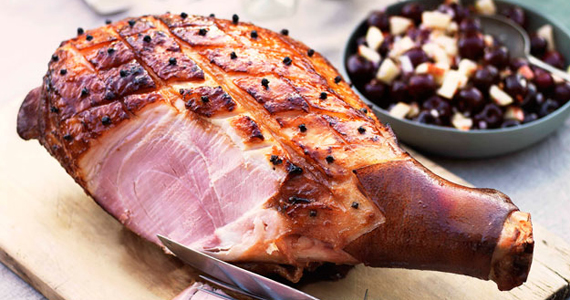
Ham
Glazed ham has always been a Christmas classic, and nowadays you can spend as little as $40 or as much as $140 on the said leg of ham, with endless varieties at your fingertips – bone in, bone out, easy-carve, triple-smoked, free-range, soccerball, honey or rosemary, cloves or no cloves, hormone-free and from a specific area of Australia, from Tasmania to Gymea. These top tips will help avoid a Christmas Day Aftermath meltdown while still providing fabulous festive food and hosting a successful feast!
Store |
Always follow storage instructions! Your ham will keep for several weeks with proper handling. Reduced salt hams, while healthier, will not last as long as conventional hams so it’s particularly important to follow the instructions on the packaging.
As always, planning ahead is very important!
- A leg of ham needs to be stored in the refrigerator.
- A special ham bag or clean cotton pillowcase will keep freshness and maintain quality.
- The bag/pillowcase will need to be changed or washed and dried every 3 days.
- Ham will keep better whole than sliced, so only slice off what is needed!
Cook |
Leftover sliced ham can be kept in the fridge for up to 3 days if wrapped in plastic or foil. Sliced meat can also be put back under the skin flap of a ham leg on the bone and stored in the ham bag or cotton pillowcase. It’s also possible to freeze leftover slices or the ham bone for homemade soup when the weather cools.
When it comes to glazing your ham, there are so many options! From cloves and honey to oranges, mustard and fig, maple syrup and pineapples…your options really are endless, and it’s an excellent opportunity to experiment with new flavours or stick with old family favourites.
Find out more about how to glaze your ham at Feast! Fine Foods.
Buy |
The first step to having the best possible ham is to select quality produce. You should look for a ham that has plenty of marbling through the leg, as these ham pieces maintain moisture better. Although most varieties of ham you purchase are pre cooked, if you want to go that extra mile, adding a glaze to your ham is something that always makes your ham look even better on the plate.
Goodfood.com.au states that price is a good guide to establish aspects of ham processing, as traditional wood smoking is a slower process used to produce more expensive meat, while liquid smoke, applied by aerosol or dipping the meat in a bath, is used in cheaper products.
Fun Fact |
Beware the Christmas ham!
In 2010, New Zealand’s state-run Accident Compensation Corporation (ACC), released figures today showing the cost of treatment, rehabilitation and compensation for accidents recorded on that Christmas Day have topped $NZ1.9 million ($1.45 million AUD).
That includes several claims for ham-related injuries – including carving mishaps and burns, neck and knee strains from carrying heavy hams, and even a crushed finger after a ham toppled from a stand.
So be careful and don’t forget to bend your knees when you lift!


